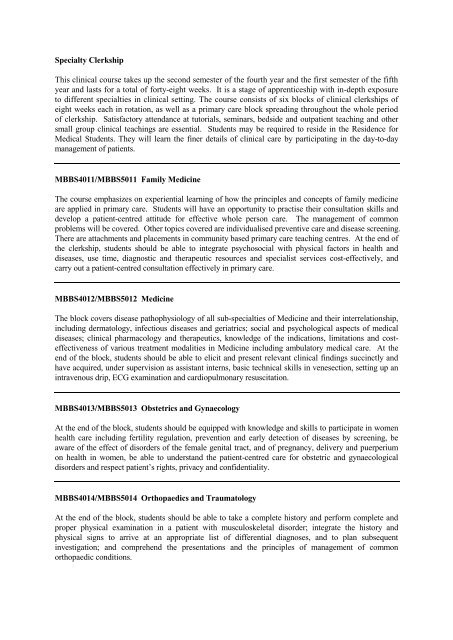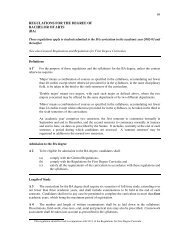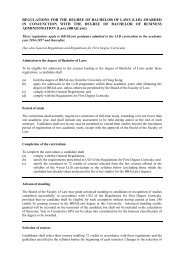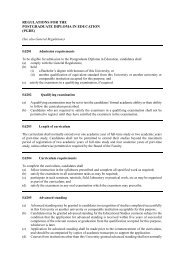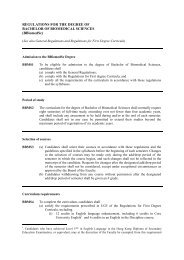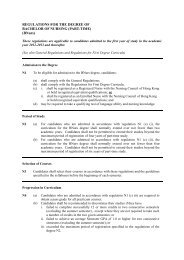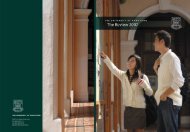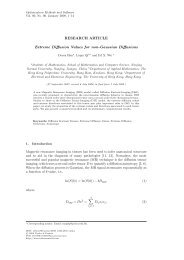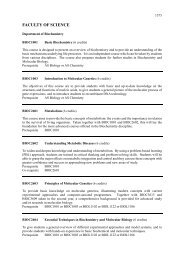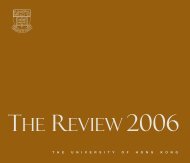(MBBS) (5-year-programme) - The University of Hong Kong
(MBBS) (5-year-programme) - The University of Hong Kong
(MBBS) (5-year-programme) - The University of Hong Kong
You also want an ePaper? Increase the reach of your titles
YUMPU automatically turns print PDFs into web optimized ePapers that Google loves.
Specialty ClerkshipThis clinical course takes up the second semester <strong>of</strong> the fourth <strong>year</strong> and the first semester <strong>of</strong> the fifth<strong>year</strong> and lasts for a total <strong>of</strong> forty-eight weeks. It is a stage <strong>of</strong> apprenticeship with in-depth exposureto different specialties in clinical setting. <strong>The</strong> course consists <strong>of</strong> six blocks <strong>of</strong> clinical clerkships <strong>of</strong>eight weeks each in rotation, as well as a primary care block spreading throughout the whole period<strong>of</strong> clerkship. Satisfactory attendance at tutorials, seminars, bedside and outpatient teaching and othersmall group clinical teachings are essential. Students may be required to reside in the Residence forMedical Students. <strong>The</strong>y will learn the finer details <strong>of</strong> clinical care by participating in the day-to-daymanagement <strong>of</strong> patients.<strong>MBBS</strong>4011/<strong>MBBS</strong>5011 Family Medicine<strong>The</strong> course emphasizes on experiential learning <strong>of</strong> how the principles and concepts <strong>of</strong> family medicineare applied in primary care. Students will have an opportunity to practise their consultation skills anddevelop a patient-centred attitude for effective whole person care. <strong>The</strong> management <strong>of</strong> commonproblems will be covered. Other topics covered are individualised preventive care and disease screening.<strong>The</strong>re are attachments and placements in community based primary care teaching centres. At the end <strong>of</strong>the clerkship, students should be able to integrate psychosocial with physical factors in health anddiseases, use time, diagnostic and therapeutic resources and specialist services cost-effectively, andcarry out a patient-centred consultation effectively in primary care.<strong>MBBS</strong>4012/<strong>MBBS</strong>5012 Medicine<strong>The</strong> block covers disease pathophysiology <strong>of</strong> all sub-specialties <strong>of</strong> Medicine and their interrelationship,including dermatology, infectious diseases and geriatrics; social and psychological aspects <strong>of</strong> medicaldiseases; clinical pharmacology and therapeutics, knowledge <strong>of</strong> the indications, limitations and costeffectiveness<strong>of</strong> various treatment modalities in Medicine including ambulatory medical care. At theend <strong>of</strong> the block, students should be able to elicit and present relevant clinical findings succinctly andhave acquired, under supervision as assistant interns, basic technical skills in venesection, setting up anintravenous drip, ECG examination and cardiopulmonary resuscitation.<strong>MBBS</strong>4013/<strong>MBBS</strong>5013 Obstetrics and GynaecologyAt the end <strong>of</strong> the block, students should be equipped with knowledge and skills to participate in womenhealth care including fertility regulation, prevention and early detection <strong>of</strong> diseases by screening, beaware <strong>of</strong> the effect <strong>of</strong> disorders <strong>of</strong> the female genital tract, and <strong>of</strong> pregnancy, delivery and puerperiumon health in women, be able to understand the patient-centred care for obstetric and gynaecologicaldisorders and respect patient’s rights, privacy and confidentiality.<strong>MBBS</strong>4014/<strong>MBBS</strong>5014 Orthopaedics and TraumatologyAt the end <strong>of</strong> the block, students should be able to take a complete history and perform complete andproper physical examination in a patient with musculoskeletal disorder; integrate the history andphysical signs to arrive at an appropriate list <strong>of</strong> differential diagnoses, and to plan subsequentinvestigation; and comprehend the presentations and the principles <strong>of</strong> management <strong>of</strong> commonorthopaedic conditions.


